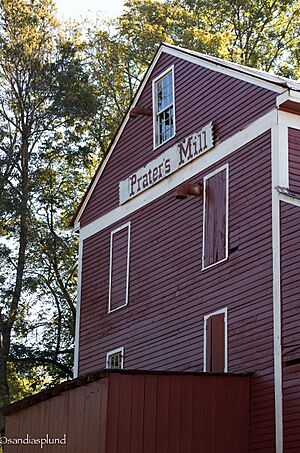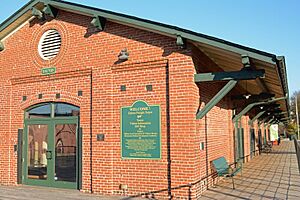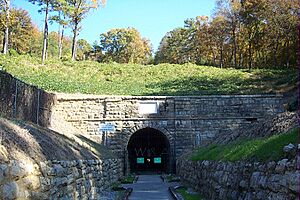National Register of Historic Places listings in Whitfield County, Georgia facts for kids
Did you know that many special buildings and places in the United States are officially recognized for their history? These places are listed on something called the National Register of Historic Places (NRHP). It's like a special club for buildings, homes, and areas that have played an important part in history.
In Whitfield County, Georgia, there are several amazing places that are on this list. They help us remember the past and learn about how people lived long ago. Let's explore some of these cool historic spots!
Contents
Historic Gems in Whitfield County
Whitfield County is home to many fascinating historic sites. Each one has a unique story to tell. From old homes to busy commercial areas and even a railroad tunnel, these places show us different parts of history.
Homes with History
Many old homes in Dalton are on the National Register. These houses often show us how people lived and what kind of architecture was popular many years ago.
- Thomas A. Berry House: This house, located at 506 Hawthorne Street, was added to the list in 1984.
- Ainsworth E. Blunt House: Found at 506 S. Thornton Avenue, this house joined the list in 1980.
- William C. Martin House: You can find this historic home at 101 S. Selvidge Street. It was recognized in 1982.
These homes are important because they help us understand the past through their design and the stories of the families who lived there.
Busy Historic Districts
Sometimes, it's not just one building that's historic, but a whole area! These are called historic districts. They are groups of buildings that together tell a bigger story about a town or community.
- Crown Mill Historic District: This district is located along U.S. 41 in Dalton. It was added to the list in 1979. It reminds us of the area's industrial past.
- Dalton Commercial Historic District: This important district covers the main business area of Dalton. It includes streets like Hamilton, Pentz, Waugh, and Morris. It was first listed in 1988, and later expanded in 2006. This district shows how Dalton grew as a town.
- McCarty Subdivision Historic District: This neighborhood district includes streets like Thornton Place and Walnut Avenue. It was recognized in 2002. It gives us a peek into how residential areas developed.
- Thornton Avenue-Murray Hill Historic District: This district is roughly bounded by Crawford Street and Thornton Avenue. It was added to the list in 1992. It's another example of a historic neighborhood in Whitfield County.
Special Buildings and Places
Beyond homes and districts, Whitfield County has other unique historic spots.
- Masonic Lodge No. 238: Located at 600 S. Hamilton Street, this building was listed in 1996. It's a significant building for the local community.
- A. D. Strickland Store: This old store at 1385 Dawnville Road was added to the list in 2005. It gives us a glimpse into how local businesses operated long ago.
Prater's Mill
Prater's Mill is a very special place located north of Dalton. It was listed on the National Register in 1978. This old grist mill is a great example of early industry in the area. It shows how people used water power to grind grain. Today, it's a popular spot for festivals and events, bringing history to life!
Western and Atlantic Depot
The Western and Atlantic Depot in Dalton is a historic train station. It's located at the west end of King Street. Built in 1914, this depot played a big role in connecting Dalton to other parts of the country by train. It was listed in 1978 and was renovated in 2009. Today, it serves as a visitor's center, welcoming people to Dalton. It's also part of the larger Dalton Commercial Historic District.
Western and Atlantic Railroad Tunnel at Tunnel Hill
One of the most exciting historic sites is the Western and Atlantic Railroad Tunnel at Tunnel Hill. This tunnel was a huge engineering feat when it was built. It was listed on the National Register in 2002. Imagine trains traveling through this tunnel many years ago! It's a reminder of the important role railroads played in developing the region.
Images for kids













